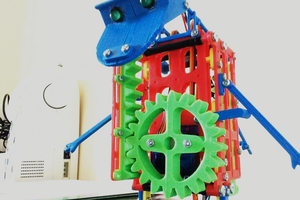Rapid circuit prototype with a 3D printer and conductive filament.
This project features a simple circuit designed to explain the working and use of a 555 timer IC.
The connection used is credited to this blog LED Flasher Circuit
The 555 timer was one of the first IC chips I learned to use in a project back when I attended community college. I learned to read the datasheet and create my first flashing LED! This is a good place to start for those new to electronics.
*I recommend reading the 555 timer datasheet to learn more!
Note: When the print is 7% to 8% complete, the conductive filament should follow. Here is a great Instructable for welding 3D filament Filament Fuser.
*I simply snipped off the colored PLA with a wire cutter, then guided the conductive filament into the 3D printer until the extruder accepted (grabbed) it.
 Bits4Bots
Bits4Bots
 igorfonseca83
igorfonseca83

 SelfCAD
SelfCAD
 Robin Hartley
Robin Hartley